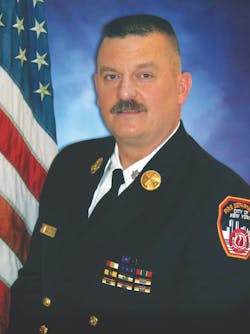Let me begin with this: Nobody knows it all—even though a few folks in the fire service believe that they do. If you start counting the items, facts, procedures and methods that the typical back-step firefighter must know, you might be surprised at how long the list is. Just as important in this discussion: continually training, practicing, reading and discussing the many things that you are expected to know.
Engine operations
Every firefighter and company officer must be well versed on how to select the correct size and length of hoseline for a structural fire attack. Next up are the proper and most effective way to stretch and advance that line into a fire and the correct nozzle techniques.
Before you even touch the hose, you must be properly and quickly dressed in your protective gear and don the SCBA. This includes chin strap, gloves and earflaps.
Roof operations
Truckies must select the correct portable ladder, carry it properly, and raise and extend it to their destination, which also must be correctly selected. They must know how to climb and dismount that ladder and be able to do that while they carry a hand tool or a power saw.
As for that saw, how does it start? Was the correct saw/blade for the operation selected? Where on the roof should the vent hole be cut?
Cutting with the saw isn’t a simple task. Blade speed, depth of cut and how rapidly to pull the saw through the cut are vital. What shape or sequence of cuts should be used? What is the wind direction while cutting?
Second engine
When the second engine arrives and is ordered to lay a supply line for the first engine, what size hose should be used for that operation? Should the coupling be connected directly to the hydrant, or should a gate be inserted between the hydrant and the hose coupling?
Back at the pumper, where is this supply line connected to the pump? Which are discharges and which are intakes?
After laying the supply line, the second engine is ordered to stretch a second line to the front of the fire building. Does the size of the first line affect the decision about the size of the second line? How many lengths should the second line be? Is it to back up the first line or to operate on the floor above the fire?
Search
Say other ladder company firefighters are searching for a reported missing person in the fire apartment. After entering the flat, should they penetrate to the room or area that’s involved to begin the search there? Begin back toward the entrance door? Should they begin the search immediately upon entering the apartment?
Should these firefighters vent as they search without communicating with the engine officer or should they coordinate venting with the fire attack?
When searching a room, should the firefighter complete the search of that room first before proceeding through any doorways into adjacent rooms?
Is it appropriate for a team of two firefighters to split up in the hallway and each search a room that’s on opposite sides of the hall?
When encountering a closet during a bedroom search, how far into that closet should the search go?
A long list
What’s above doesn’t even cover checking the apparatus at the start of the tour or on drill night or the technical procedures to check the serviceability of the saw(s), extrication equipment, meters, radios, SCBA and forcible entry tools. High-angle, confined-space, hazmat and EMS operations aren’t covered either.
Who knows it all?
About the Author
John J. Salka Jr.
Battalion Chief
JOHN J. SALKA JR., who is a Firehouse contributing editor, retired as a battalion chief with FDNY, serving as commander of the 18th battalion in the Bronx. Salka has instructed at several FDNY training programs, including the department’s Probationary Firefighters School, Captains Management Program and Battalion Chiefs Command Course. He conducts training programs at national and local conferences and has been recognized for his firefighter survival course, “Get Out Alive.” Salka co-authored the FDNY Engine Company Operations manual and wrote the book "First In, Last Out–Leadership Lessons From the New York Fire Department." He also operates Fire Command Training, which is a New York-based fire service training and consulting firm.

